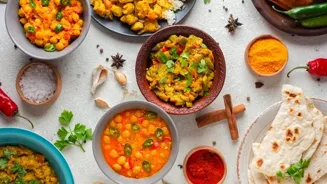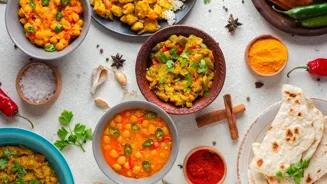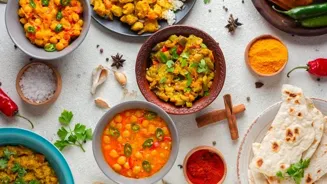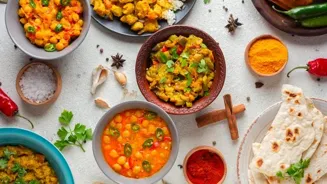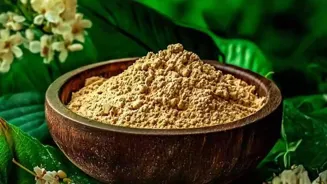Discover the ancient wisdom of Ayurveda in Indian cooking! Explore how it nurtures body and mind through flavors and spices
For centuries, Indian cooking has been more than just about taste; it's been intrinsically
linked to health and well-being, guided by the ancient principles of Ayurveda. This traditional system of medicine emphasizes balancing the body's doshas - Vata, Pitta, and Kapha - through diet and lifestyle.
And believe it or not, your everyday dal and sabzi are playing a bigger role in that balance than you might think! So, let's take a peek inside the Ayurvedic kitchen and discover how it adds a dose of health to every delicious meal.
Ayurveda: Food as medicine, balancing six tastes for holistic health
Ayurveda views food as medicine, emphasizing that what we eat directly impacts our physical and mental state. The unique contribution of Ayurvedic cooking lies in its understanding of the six tastes - sweet, sour, salty, pungent, bitter, and astringent.
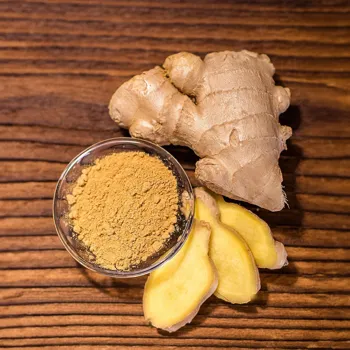
Each taste affects the doshas differently, and a balanced meal incorporates all six to promote harmony within the body. Think of it as a symphony of flavors, each playing its part to create a harmonious whole.
The aim is not just to satisfy hunger, but to nourish the body and mind, supporting overall health and vitality. This approach makes Indian cuisine not just flavorful, but also deeply therapeutic.
For instance, a simple khichdi, often prescribed during illness, is a perfect example of an Ayurvedic recipe, easy to digest and nourishing for all doshas.
Ayurvedic cooking: Spices enhance flavor and offer medicinal benefits
Spices are the heart and soul of Ayurvedic cooking, acting as both flavor enhancers and potent medicinal agents. Turmeric, ginger, cumin, coriander, and cardamom, are just a few of the spices that feature prominently in Indian dishes, each possessing unique healing properties.
Turmeric, with its anti-inflammatory and antioxidant properties, is a staple in curries and dals. Ginger, known for its digestive benefits, is used in teas and stir-fries. Cumin aids digestion and boosts immunity, while coriander cools the body and balances Pitta dosha.
Cardamom, with its aromatic flavor, adds a touch of sweetness and helps in digestion. The strategic use of these spices not only elevates the taste of the food but also transforms it into a powerful tool for promoting health and preventing disease.
Understanding the properties of different spices allows you to personalize your cooking to suit your individual needs and restore balance within your system.
Ayurvedic cooking focuses on strong agni for digestion and health
The concept of "agni," or digestive fire, is central to Ayurvedic cooking. Ayurveda emphasizes the importance of maintaining a strong agni to efficiently digest food and absorb nutrients.
When agni is weak, food remains undigested, leading to the accumulation of toxins, known as "ama," which can contribute to various health problems. Ayurvedic cooking techniques aim to stimulate and support agni.
This includes using digestive spices like ginger, cumin, and pepper, avoiding excessive cold or raw foods, and eating meals at regular intervals. Proper food combining is also crucial, as certain food combinations can weaken agni and hinder digestion.
For example, consuming fruits with meals is generally discouraged as fruits digest faster than other foods, leading to fermentation and indigestion.
By paying attention to agni and following Ayurvedic principles of food combining, you can optimize digestion, prevent toxin buildup, and promote overall health.
Adapt Ayurvedic principles to cooking with small, mindful choices
Adapting Ayurvedic principles to your cooking doesn't require a complete overhaul of your diet. It's about making small, conscious choices that align with your individual needs and promote balance.
Start by incorporating more spices into your meals, experimenting with different combinations to find what works best for you. Pay attention to your body's signals and adjust your diet according to your dosha.
If you tend to feel hot and irritable (Pitta imbalance), focus on cooling foods like cucumber, coriander, and coconut. If you feel sluggish and congested (Kapha imbalance), incorporate warming spices like ginger, pepper, and mustard seeds.
Make mindful eating a practice, savoring each bite and paying attention to how different foods affect your energy levels and mood. Embrace traditional recipes and cooking methods, as they often embody the wisdom of Ayurveda.
Ayurvedic cooking: holistic health through doshas, spices, and balance
Ayurvedic cooking is more than just a culinary tradition; it's a holistic approach to health and well-being. By understanding the principles of doshas, tastes, spices, and agni, you can transform your kitchen into a source of healing and nourishment.
Instead of following fad diets or restrictive eating plans, Ayurvedic cooking encourages you to connect with your body's needs and cultivate a balanced and sustainable approach to eating. After all, true wellness begins in the kitchen!
Every meal becomes opportunity to nurture not just your body, but also boost peace of your mind. This age old approach still finds its purpose and has a place in Indian cooking.


